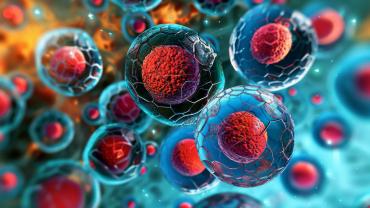
Cellular senescence is an important biological process associated with age-related diseases (ARD). It is marked by the buildup of senescent cells that have diminished ability to proliferate and often trigger inflammation. Remarkably, the human body exhibits the continuous ability to generate new tissues, develop organs, and promote the removal of senescent cells. Stem and progenitor cells contribute uniquely to this process by regenerating and repairing tissue at the cellular level, thereby promoting optimal metabolic function.
While both stem and progenitor cells have the fundamental capacity to differentiate into various cell types, they also exhibit distinguishing characteristics that influence their overall contributions to cellular regeneration.
A Closer Look at Stem and Progenitor Cell Classifications
Stem cells are unspecialized, self-renewing cells with the ongoing growth potential to generate new tissue and replace damaged or dying cells. They possess different types of developmental potential, including totipotent, pluripotent, and multipotent stem cells, which affect the specialization and roles of future cell production. Each type of stem cell fulfills a distinct function in promoting cellular health, both during the embryonic developmental phase and in adulthood, where it contributes to cellular repair.
Progenitor cells may be regarded as an intermediary cell type positioned between stem cells and fully differentiated cells. They possess a limited ability to proliferate exclusively into their lineage-specific target cells. Notably, each organ system has its own stem cell source that supports the differentiation of progenitor cells unique to its respective organ tissues. Stimulated by damaged cells and tissue injuries, progenitor cells fulfill a critical role in normal tissue recovery. This mechanism of action may be pivotal in helping attenuate the effects of senescence and influencing health by promoting cellular regeneration, especially for cardiovascular tissues.
Totipotent Stem Cells
With the highest level of differentiation potential, totipotent stem cells can transform into any cell within the whole organism. They are present solely in the initial stages of embryonic development and aid in the formation of extraembryonic tissues, like the amniotic sac and placenta, during pregnancy. Embryonic stem cells (ESCs) possess the distinct capability to proliferate and differentiate into pluripotent cells indefinitely, ultimately contributing to the formation of various tissue lineages, including the endodermal, ectodermal, and mesodermal tissue layers.
Pluripotent Stem Cells
Pluripotent stem cells (PSCs) originate from either ESCs during early development or from induced pluripotent stem cells (iPSCs) in adults. During embryonic development, the ectodermal layers create surface tissues like hair and nails, as well as neuroectodermal tissues that develop into the brain, spinal cord, and peripheral nerves. The mesodermal layer gives rise to bone, blood, and muscle tissues, while endodermal cells form layers of tissue for the gastrointestinal tract, thyroid, and respiratory system.
iPSCs are commonly utilized to create restorative cells for patients with injured or diseased tissues. Sourced from the patient’s own cells, iPSCs represent an optimal resource for promoting cellular repair, as they present a minimal risk of immune rejection. Ongoing clinical trials may further elucidate any therapeutic application of iPSCs for various conditions, such as endothelial dysfunction and neurodegenerative diseases.
Multipotent Stem Cells
While multipotent stem cells are well-known for their ability to differentiate into multiple cell types, they are limited to their specific lineage for tissues, organs, or systems. Hematopoietic stem cells (HSCs) represent a category of multipotent cells that are located in bone marrow and umbilical cord blood, and they are frequently utilized in bone marrow transplants. Their ability to differentiate into red and white blood cells and platelets makes them a viable treatment option for blood disorders.
Endothelial progenitor cells (EPCs), originating from both HSCs and non-HSCs, are bone marrow or umbilical cord-derived cells responsible for facilitating the endothelial and vascular repair process and negatively correlate with cardiovascular disease (CVD) burden. Several cardiovascular disease-related pathologies affecting endothelial cells include impaired vascular relaxation, decreased angiogenesis, and local and systemic inflammation. These factors can elevate the risk of developing atherosclerosis, hypertension, peripheral artery disease, and ischemic heart disease.
Managed endothelial cell behavior may promote healthy vascular tissue regeneration and support overall cardiometabolic health. Bioactive peptides serve multiple functions in the human body, including angiogenesis regulation, promoting cellular differentiation, scaffolding natural materials for tissue repair, and serving as signaling molecules in vascular intracellular pathways. The versatile nature of peptides may promote cardiovascular health by stimulating both local and circulating progenitor cells to aid in the body’s normal tissue repair.
Multipotent mesenchymal stem cells (MSCs) are also found within the bone marrow and can differentiate into adipose, bone, and chondrocyte cells. This characteristic makes MSCs crucial for cartilage repair, as chondrocytes derived from MSCs are essential for enhancing extracellular matrix composition, reducing inflammation, and fostering tissue renewal.
Additionally, multipotent neural stem cells (NPCs) are crucial for brain development, particularly during embryonic cellular and tissue formation in the neural crest (NC) and cortex. In adults, NPCs may support neuroplasticity, learning, and memory through neurogenesis in the lateral ventricles and hippocampal areas of the brain.
Overall, stem and progenitor cells both play a critical role in tissue development, repair, and regeneration. While stem cells offer broad potential through self-renewal and multipotency, progenitor cells provide efficient and targeted pathways to specialized cell types. As research progresses, harnessing the unique capabilities of stem and progenitor cells for tissue regeneration and repair will be essential in developing precise and effective therapies, transforming our approach to human health and well-being.
To learn more about regeneration, repair, and cellular health:
Decoding Peptides: The Body’s Little Helpers
Pterostilbene: A Molecule to Support Cellular Regeneration
Resveratrol and the Immunology of Senescent Cells
The Intelligent Inner Lining of Blood Vessels: Nutrients that Support Vascular Health
By Rachel B. Johnson, MS, CNS, LDN